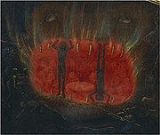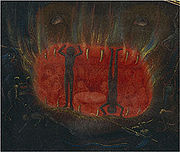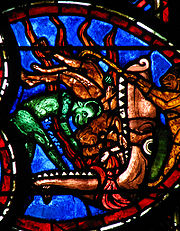
Hellmouth
Encyclopedia




Hell
In many religious traditions, a hell is a place of suffering and punishment in the afterlife. Religions with a linear divine history often depict hells as endless. Religions with a cyclic history often depict a hell as an intermediary period between incarnations...
envisaged as the gaping mouth of a huge monster, an image which first appears in Anglo-Saxon art
Anglo-Saxon art
Anglo-Saxon art covers art produced within the Anglo-Saxon period of English history, beginning with the Migration period style that the Anglo-Saxons brought with them from the continent in the 5th century, and ending in 1066 with the Norman Conquest of a large Anglo-Saxon nation-state whose...
, and then spread all over Europe, remaining very common in depictions of the Last Judgment
Last Judgment
The Last Judgment, Final Judgment, Day of Judgment, Judgment Day, or The Day of the Lord in Christian theology, is the final and eternal judgment by God of every nation. The concept is found in all the Canonical gospels, particularly the Gospel of Matthew. It will purportedly take place after the...
and Harrowing of Hell
Harrowing of Hell
The Harrowing of Hell is a doctrine in Christian theology referenced in the Apostles' Creed and the Athanasian Creed that states that Jesus Christ "descended into Hell"...
until the end of the Middle Ages
Middle Ages
The Middle Ages is a periodization of European history from the 5th century to the 15th century. The Middle Ages follows the fall of the Western Roman Empire in 476 and precedes the Early Modern Era. It is the middle period of a three-period division of Western history: Classic, Medieval and Modern...
, and still sometimes used during the Renaissance
Renaissance
The Renaissance was a cultural movement that spanned roughly the 14th to the 17th century, beginning in Italy in the Late Middle Ages and later spreading to the rest of Europe. The term is also used more loosely to refer to the historical era, but since the changes of the Renaissance were not...
and after. It enjoyed something of a revival in polemical popular print
Popular print
Popular Prints is a term for printed images of generally low artistic quality which were sold cheaply in Europe and later the New World from the 15th to 18th centuries, often with text as well as images. They were the first mass-media...
s after the Protestant Reformation
Protestant Reformation
The Protestant Reformation was a 16th-century split within Western Christianity initiated by Martin Luther, John Calvin and other early Protestants. The efforts of the self-described "reformers", who objected to the doctrines, rituals and ecclesiastical structure of the Roman Catholic Church, led...
, when figures from the opposite side would be shown disappearing into the mouth. A notable late appearance is in the two versions of a painting by El Greco
El Greco
El Greco was a painter, sculptor and architect of the Spanish Renaissance. "El Greco" was a nickname, a reference to his ethnic Greek origin, and the artist normally signed his paintings with his full birth name in Greek letters, Δομήνικος Θεοτοκόπουλος .El Greco was born on Crete, which was at...
of about 1578. Political cartoons still showed Napoleon leading his troops into one.
Medieval theatre
Medieval theatre
Medieval theatre refers to the theatre of Europe between the fall of the Western Roman Empire in the 5th century A.D. and the beginning of the Renaissance in approximately the 15th century A.D...
often had a hellmouth prop
Theatrical property
A theatrical property, commonly referred to as a prop, is an object used on stage by actors to further the plot or story line of a theatrical production. Smaller props are referred to as "hand props". Larger props may also be set decoration, such as a chair or table. The difference between a set...
or mechanical device which was used to attempt to scare the audience by vividly dramatizing an entrance to Hell
Hell
In many religious traditions, a hell is a place of suffering and punishment in the afterlife. Religions with a linear divine history often depict hells as endless. Religions with a cyclic history often depict a hell as an intermediary period between incarnations...
. These seem often to have featured a battlement
Battlement
A battlement in defensive architecture, such as that of city walls or castles, comprises a parapet , in which portions have been cut out at intervals to allow the discharge of arrows or other missiles. These cut-out portions form crenels...
ed castle entrance, in painting usually associated with Heaven
Heaven
Heaven, the Heavens or Seven Heavens, is a common religious cosmological or metaphysical term for the physical or transcendent place from which heavenly beings originate, are enthroned or inhabit...
.
The oldest example of an animal Hellmouth known to Meyer Schapiro
Meyer Schapiro
Meyer Schapiro was a Lithuanian-born American art historian known for forging new art historical methodologies that incorporated an interdisciplinary approach to the study of works of art...
was an ivory carving of c. 800 in the Victoria and Albert Museum
Victoria and Albert Museum
The Victoria and Albert Museum , set in the Brompton district of The Royal Borough of Kensington and Chelsea, London, England, is the world's largest museum of decorative arts and design, housing a permanent collection of over 4.5 million objects...
, and he says most examples before the 12th century are English. Schapiro speculates that the image may have drawn from the pagan myth of the Crack of Doom
Crack of Doom
The Crack of Doom is an old term used for the Christian Day of Judgement, referring in particular to the blast of trumpets signalling the end of the world in Chapter 8 of the Book of the Apocalypse...
, with the mouth that of the wolf-monster Fenrir, slain by Vidar
Vidar
In Norse mythology, Víðarr is a god among the Æsir associated with vengeance. Víðarr is described as the son of Odin and the jötunn Gríðr, and is foretold to avenge his father's death by killing the wolf Fenrir at Ragnarök, a conflict which he is described as surviving...
, who is used as a symbol of Christ on the Gosforth Cross
Gosforth cross
upright|thumb|Gosforth Cross outside St Mary's church in Gosforth.The Gosforth Cross is a large stone Anglo-Saxon high cross in the churchyard at Gosforth in the English county of Cumbria. Formerly part of the kingdom of Northumbria, the area was settled by Scandinavians some time in either the 9th...
and other pieces of Anglo-Scandinavian art. In the assimilation of Christianised Viking
Viking
The term Viking is customarily used to refer to the Norse explorers, warriors, merchants, and pirates who raided, traded, explored and settled in wide areas of Europe, Asia and the North Atlantic islands from the late 8th to the mid-11th century.These Norsemen used their famed longships to...
populations in northern England, the Church was surprisingly ready to allow the association of pagan mythological images with Christian ones, in hogback
Hogback (sculpture)
Hogbacks are stone carved Anglo-Scandinavian sculptures from 10th-12th century England and Scotland. Their function is generally accepted as grave markers.-Geography and description:...
grave markers for example.
In the Anglo-Saxon Vercelli Homilies
Vercelli Homilies
The Vercelli homilies are a collection of twenty-three prose entries within the Vercelli book and exist as an important example of Old English prose structure, owing to the predominance of poetry within the pool of extant Old English literature. In keeping with the origins of the Vercelli...
(4:46-8) Satan is likened to a dragon
Dragon
A dragon is a legendary creature, typically with serpentine or reptilian traits, that feature in the myths of many cultures. There are two distinct cultural traditions of dragons: the European dragon, derived from European folk traditions and ultimately related to Greek and Middle Eastern...
swallowing the damned:
"... ne cumaþ þa næfre of þæra wyrma seaðe & of þæs dracan ceolan
þe is Satan nemned." - "[they] never come out of the pit of snakes and of the throat of the dragon which is called Satan."
The whale-monster Leviathan
Leviathan
Leviathan , is a sea monster referred to in the Bible. In Demonology, Leviathan is one of the seven princes of Hell and its gatekeeper . The word has become synonymous with any large sea monster or creature...
(translated from Hebrew
Hebrew language
Hebrew is a Semitic language of the Afroasiatic language family. Culturally, is it considered by Jews and other religious groups as the language of the Jewish people, though other Jewish languages had originated among diaspora Jews, and the Hebrew language is also used by non-Jewish groups, such...
, Job
Book of Job
The Book of Job , commonly referred to simply as Job, is one of the books of the Hebrew Bible. It relates the story of Job, his trials at the hands of Satan, his discussions with friends on the origins and nature of his suffering, his challenge to God, and finally a response from God. The book is a...
41:1, "wreathed animal") has been equated with this description, although this is hard to confirm in the earliest appearances. However in The Whale, an Old English poem from the Exeter Book
Exeter Book
The Exeter Book, Exeter Cathedral Library MS 3501, also known as the Codex Exoniensis, is a tenth-century book or codex which is an anthology of Anglo-Saxon poetry. It is one of the four major Anglo-Saxon literature codices. The book was donated to the library of Exeter Cathedral by Leofric, the...
, the mouth of Hell is compared to a whale's mouth, though somewhat indirectly:
The whale has another trick: when he is hungry, he opens his mouth and a sweet smell comes out. The fish are tricked by the smell and they enter into his mouth. Suddenly the whale’s jaws close.
Likewise, any man who lets himself be tricked by a sweet smell and led to sin will go into hell, opened by the devil — if he has followed the pleasures of the body and not those of the spirit. When the devil has brought them to hell, he clashes together the jaws, the gates of hell. No one can get out from them, just as no fish can escape from the mouth of the whale.
Later in the Middle Ages the classical Cerberus
Cerberus
Cerberus , or Kerberos, in Greek and Roman mythology, is a multi-headed hound which guards the gates of the Underworld, to prevent those who have crossed the river Styx from ever escaping...
also became associated with the image, although it is hardly likely that the Anglo-Saxons had him in mind.
Satan himself is often shown sitting in Hell eating the damned, but according to G.D. Schmidt this is a separate image, and the Hellmouth should not be considered to be the mouth of Satan, although Hofmann is inclined to disagree with this. Equally the Hellmouth never bites the damned, remaining wide open, ready for more.
In popular culture
- The fantasy/horror series, Buffy the Vampire Slayer, displays the "Hellmouth" in many episodes
- The horror video game by id SoftwareId SoftwareId Software is an American video game development company with its headquarters in Richardson, Texas. The company was founded in 1991 by four members of the computer company Softdisk: programmers John Carmack and John Romero, game designer Tom Hall, and artist Adrian Carmack...
, Doom 3Doom 3Doom 3 is a science fiction horror video game developed by id Software and published by Activision. An example of the first-person shooter genre, Doom 3 was first released for Microsoft Windows on August 3, 2004. The game was later adapted for Linux, as well as being ported by Aspyr Media for Mac...
, has a Hellmouth - In the serie of SupernaturalSupernaturalThe supernatural or is that which is not subject to the laws of nature, or more figuratively, that which is said to exist above and beyond nature...
, Sam WinchesterSam WinchesterSamuel "Sam" Winchester is a fictional character and one of the two main protagonists of The CW Television Network's Supernatural along with his older brother Dean. He is portrayed by Jared Padalecki.-Background:...
(Jared PadaleckiJared PadaleckiJared Tristan Padalecki is an American actor. He grew up in Texas and came to fame in the early 2000s after appearing on the television series Gilmore Girls as well as in several Hollywood films, including New York Minute and House of Wax...
) and Dean WinchesterDean WinchesterDean Winchester is a fictional character from The CW Television Network's Supernatural, portrayed by Jensen Ackles. He hunts demons, spirits and other supernatural creatures with his younger brother Sam.-Background:...
(Jensen AcklesJensen AcklesJensen Ross Ackles is an American actor. He is known for his roles in television as Eric Brady in Days of our Lives, which earned him several Daytime Emmy Award nominations, as well as Alec/X5-494 in Dark Angel and Jason Teague in Smallville...
) open the Hellmouth.
Further reading
- G. D. Schmidt, The Iconography of the Mouth of Hell:Eighth-Century Britain to the Fifteenth Century, 1995, Selinsgrove, PA, Susquehanna University Press, 1995, ISBN 0945636695
- Austin Simmons, The Cipherment of the Franks Casket (PDF) Hellmouth (or the whale as constituting Hell) is inferred in the inscription on the front side of the Franks CasketFranks CasketThe Franks Casket is a small Anglo-Saxon whalebone chest from the seventh century, now in the British Museum. The casket is densely decorated with knife-cut narrative scenes in flat two-dimensional low-relief and with inscriptions mostly in Anglo-Saxon runes...
.

